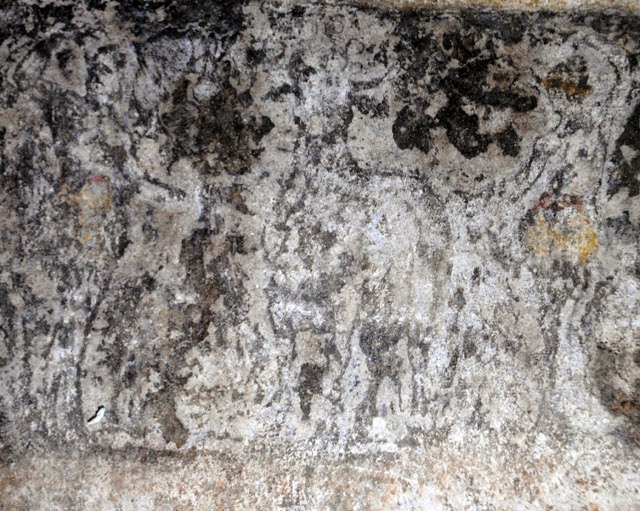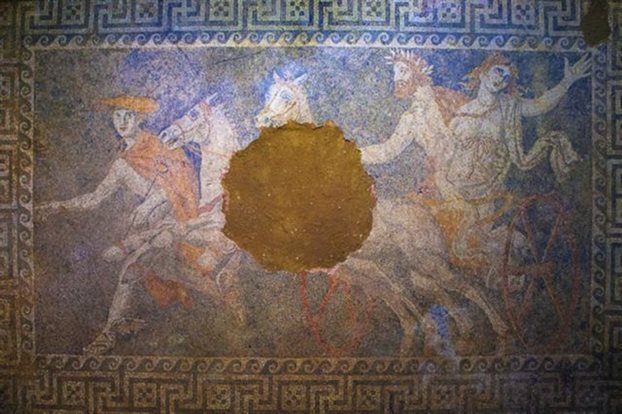In the sheet 30/9/2014 Kavala ChRONOMETRO newspaper, as well as in electronic version, in the context of the publication of a series of my articles titled "GODS, IMITHEOI AND BASILIADES IN THE MYTHOLOGY OF THE AREA MOUNT PAGGAIO PERI ", I referred extensively to the mythical King of the Thracian pangeo, the Riso, saying, already in the prologue of my articles, I quote the following: "Most very impressed with the fact that the monument every day it reveals archaeologists did not known until today form of the Macedonian tombs, but it seems like n ' copies some devotional cave pangeo, like the one in which Euripides placed the mythical King of the Thracian pangeo, the Riso, in the eponymous tragedy........... My reflections, well, does under the great tumulus of Amphipolis, with the Sphinxes that foretell the coming events, Apart from the grave of a epifanestatoy man, hiding and some Premier, spilaiiki worship, leads me to wade in ancient these myths and legends of Paggaio.... "
And although the Riso for referring to what in my related article I wrote, which you can see in the following link: http://www.xronometro.com/risos-paggaio/
The Occasion, though, to return to the ancient hero of Pageos, This new publication, It was the fact that, shortly after the publication of my article above for Riso, in the majestic tomb of the Hill "Kasta" of Amphipolis found, beneath the floor of the third Chamber, a tomb with the disturbed bones of a dead, to which, According to an announcement of the Ministry of culture, assigned hero cults. Who, though, could be the afirwismenos dead, the hero worshiped beneath the majestic monument which revealed the archaeological hoe;
In principle, I do not intend (and I can't) n ' go against the special scientists excavate the Tomb, getting, though, given the above as an announcement of the Ministry of culture, accepting, i.e., I do that in the majestic tomb of Amphipolis hero values ascribed to some dead, (even if he's not found buried beneath the third Chamber), dare, based on my knowledge of scarce, (knowledge of a simple filistoros), Add me too a case, in many cases they see everyday light, trying, though, to substantiate my case this becomes more effective.
As I mentioned in my article for the Riso, When the Athenians wanted to put their foot in rich, metalloforo area of Paggaio and decided, the 437 e.g., to send a group of settlers in the city of Nine streets of Struma, with settler in Agnwna, had to legalize their presence there. So, during the 3rd year of the 85th Olympiados...;. Let's leave, though, the Polyaino, in the 6th book of his ' Stratigimatwn ', to narrate the continuity:


Your quote above, in free translation:
"The Agnwn began to establish new York colony, wanting to colonize the so-called Nine Streets, on the Struma ' Existed but the following Oracle to the Athenians:
You're nothing willing, sons of the Athenians, to forcibly build in polypodaro place; It will be difficult for you, without the will of the gods. Why is not meant (to accomplish), before you find and bring by Troy the relic of Risos and hide it with brilliance in paternal of Earth. Only then could you to obtain glory. After God gave him the Oracle, General Agnwn sent men in Troy, that night they opened the tomb of Risos and took the bones. And after they placed the bones in a red mantle, bring on the Struma. But the barbarians who occupied the place that, the hold back to cross the river. Then the Agnwn concluded three days of libations with the barbarians and thus the night passed away and after the Struma, along with his characteristically, the hand bones of the Risos buried beside the river, Since it destroyed the ditch, built wall beneath the Moon. The day did not work and the entire project was executed in three nights. Once the barbarians, After three days, they came and saw the wall, reproaching the Agnonas, that violated the libations. He, though, He said that he did nothing wrong, because the libations spoke for three days, not for three nights. In this way the apoikise nine Agnwn Streets and the city named Amphipolis».
Next, well, the river Struma, well the Agnwn buried the remains of the ancient King of the Thracian, the Risos, According to the Polyaino, While the historian Marsyas of Philippi, at Macedonian stories, It is even clearer, After stating that the colonists buried the remains of his son Struma, the Risos, on top of a hill, They rained the Struma, While just across the street from the monument erected for the hero, built an altar, He dedicated to his mother, the Muse Clio. («Church of Clio in Ochi Amfipolei, the Risos founded across the monument, on the Hill, thereby».

Odysseus and Diomedes steal his horses Risos
So the cult of the ancient King of the Thracian pangeo, the Risos, that existed since centuries among the Thracians, was one of the official cults of the new city. The irwopoiimenos, ancient King continued to be worshipped in Amphipolis and after its foundation, as I continued to be worshipped by all the Thracians, and not only of them inhabiting around the Pangeo. We Know, Indeed, that even up to the 3rd century a.d.. the Rhesus worshipped by the Thracian tribe of Bisswn Rhodope Mountains like God, with most known qualities of the Hunter and of the therapist, which is strongly reminiscent of another God of Thracian people of all ancient Thrace, the Main hero or Ember Knight, also God the healer and Hunter and for "what many authors consider that under the two names is the same great goddess of Thracian, the highly revered in "them, This Sabazioy Dionysus or Bacchus, whose relations with our hero confirms the epilogue of "RISOS" tragedy of Euripides, According to which, Rhesus o, genomenos anthrwpodaimwn of Dionysian procession, IE genomenos from man demigod, will forever be Prophet of Bacchus, hidden in the caves of the Earth of Paggaio hides silver, where, not only will the introduction of coming events, but will send himself the divine guidance to the prophets of the, for whom will be revered God. (Lyrics 967 subs. «..th γάρ s tayton pote, t ' opsetai demas eisin nor mother, kryptos d ' ypargyroy in antrois of chthonos, keisetai Gazer faos anthrwpodaimwn, Bacchus Prophet so Paggaio toisin eidosin wkise modest rock God»).
Believing, well, that the Hill "Kasta", where excavated the great, funerary tumulus, that the Kingdom of the Struma, until the 1960s drainage works 1930, fits perfectly in the descriptions of the ancient historians who quoted and has numerous chances, It was he who hosted the relics of Risos brought the Athenian colonists from Troy, resume:
There is the remarkable, devotional set, (This three cubicles, they were excavated in a tomb of Amphipolis), which was open and visited and used, Perhaps for centuries, for the price of one performance (or more;;) irwopoiimenoys dead, (in accordance, always, What we conclude from the communications of the Ministry of Culture and anaskafews). I Think, also, given the dating of worship set, at the end of the 4th BC. century. The Rhesus, though, He was buried on a hill, beside the river Struma, the 5th b.c.. century. This seeming contradiction leads me to make the following two assumptions:
If proved, by carbon method, how the dead found beneath the third Chamber of the cult series (as well as this very burial) build-time pre-dates the cult all, (as I believe), then I also believe that this devotional set was constructed over the tomb of the hero, just because the space was already sacred, because the Thracians and the Athenian colonists of Amphipolis worshiped there irwopoiimeno mortal (anthrwpodaimona, When Euripides) Riso and so, a member of the Macedonian, the royal dynasty, (Why not himself Alexander the great;) He chose to build the magnificent, burial Tomb over the place of ancient worship of the beloved hero – semi-God of Thracians, just in order to accept this, by residents of the famous city, cults and the values that fit in a hero like the mythical King of Pageos, for whom she had spoken to Homer and had dedicated an eponymous tragedy of the Evripides. Because it raises the legitimate question as to whether the bones are those of three thousand years, a possible answer is that because the Athenians said they brought is that bones of Risos, so you need to be; Could well find some other bones to the wrapped in purple mantle and presented with a view like the Risos, in order to fulfill the Oracle!
If, again, proven, always by carbon method, that the deceased was found is a contemporary of construction time of worship set, then you need to keep looking for, on the same hill and the cavernous gaps that, of course, he hides, the hero of Amphipolis, the Riso, but that again the Member of Macedonian, the royal dynasty, who built the funerary monument of the same site, to legalise the hero and price performance in his own person! In both cases, the tumulus of Amphipolis I'm sure will do countless generations of Greeks proud for the ancients our ancestors, the wonderful myths and the brilliant culture.
THODOROS LYMPERAKIS DIMOSTHENOUS STR.
xronometro.com












.jpg)
.jpg)


























